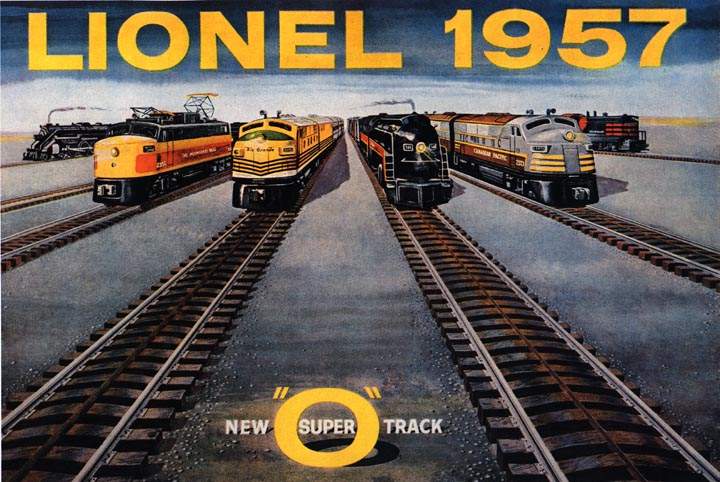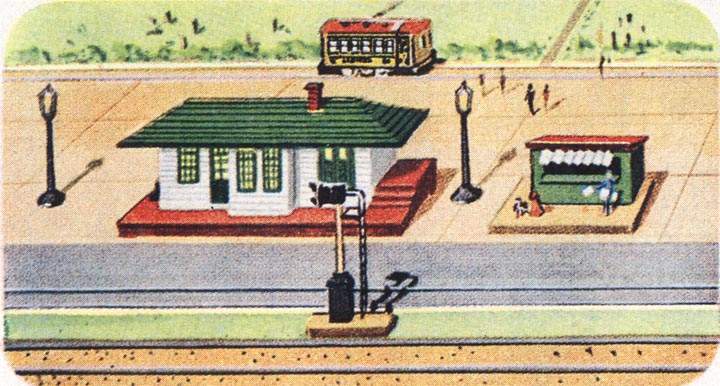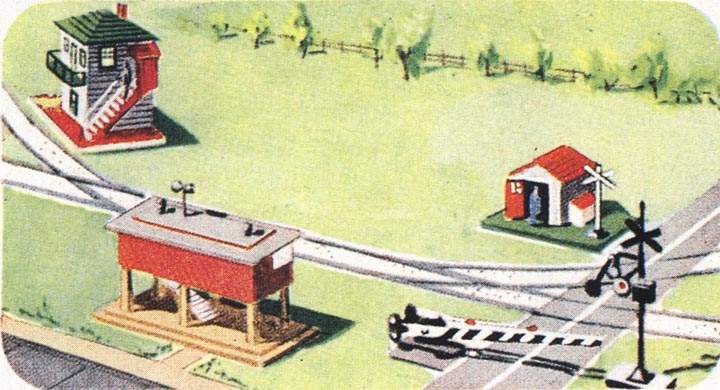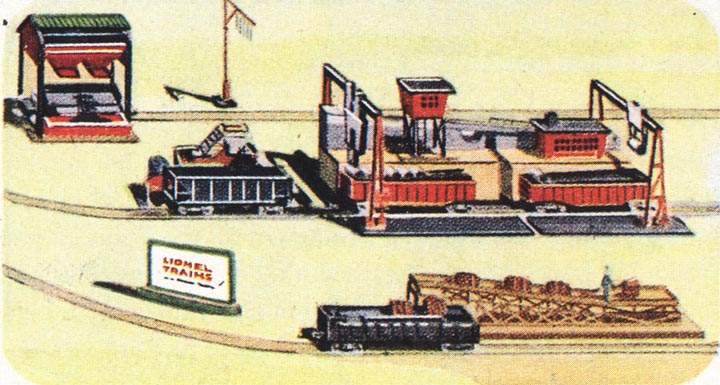Lionel’s Textbook of Model Railroading (Part II)
By Joseph H. Lechner
Last month, we followed the adventures of a young boy who received set #1585W pulled by a #602 Seaboard switcher. See Article.
(In 1957, The Lionel Corporation still presumed that trains were for boys, except when the locomotive happened to be pink.) At first, he ran his train around an oval of 027 track on the floor; later, he acquired some accessories and a pair of switches; eventually, he built a two-train layout on a 4×8 table.
Toy trains were, and continue to be, a major investment. Set #1585W retailed for $49.95 in 1957. At the federal minimum wage of $1.35 per hour, it cost some people a week’s pay. Many a cautious parent “tested the waters” by purchasing an inexpensive starter set. If a child showed continued interest, and if he demonstrated the ability to care for valuable mechanical equipment, they moved up to more elaborate sets. My first train was a used Lionel Scout at age three. It was still running, and I was still interested, at age six; so Santa brought a diesel switcher with operating cars, accessories and switches on a landscaped table.
This lucky boy on the back cover of the 1957 Lionel catalog is getting his first look at a dazzling 9’ x 14’ layout in the basement. He looks to be about six years old. Is he the same kid who received the Seaboard set a year ago? Apparently so. That’s his #602 in a cabinet underneath the table, along with the #6017 caboose that came with it and the #252 crossing gate he received as his first accessory. A new Seaboard and a new crossing gate are on the layout. Did he wear out the original ones? The drawer in front holds some of his original 027 track; he won’t be using it much any more because the new layout is Super “O”.
Pages 50-51 of the catalog showed Dad what to buy, where to put it, and how to connect it to create this wonderful model railroad. Although the purpose of a catalog was to sell Lionel equipment (and you needed a lot of it to built this layout), the copywriters transcended mere sales pitches and showed you how to use the equipment creatively. Each of the six lessons on pages 50-51 provided a close-up of one scene from the cover illustration.
Scene #1: The Depot
This was a logical place to begin, because every member of the family could relate to it. Dedicated railfans lurked in grimy railroad yards, prowled through industrial parks, or hiked to remote locations on the main line; but everyone was familiar with the small-town railway station. If you didn’t board a commuter train at a station like this one, you may have met an arriving friend there, or at least you drove past it in your Ford Fairlane en route to the grocery store or a PTA meeting.
Junior’s #133 illuminated station and #71 lamp post from his 4×8 layout have been re-used here. They have been augmented by a second lamp post, a #128 newsstand, and a #253 block signal. This scene would have been familiar to millions of Americans who commuted by rail to Boston, New York, Philadelphia, Chicago, or Los Angeles. Well-lit boarding platforms were a necessity because the trains ran at all hours from pre-dawn until after midnight. Newsstands, often cobbled together from sheets of green-painted plywood, were ubiquitous. Here Dad bought a copy of the morning paper to read on the train, but he could also get coffee and a doughnut. Mom was always lamenting that he never took time for a proper breakfast! Lionel’s newsstand was a whimsical piece of animation designed by Frank Pettit. When activated, the manager would move back and forth inside the shed; the newsboy on the sidewalk would turn to face a prospective customer; and the Dalmatian circled the fire hydrant. Lionel provided no customers with its newsstand. You were supposed to imagine yourself in the roles of magazine purchaser and commuter. #128 came with a pushbutton that you could use to start the motion. The catalog didn’t explain how, but you could wire a newsstand so that its occupants would spring into action when a train arrived. Don Woodwell tells how in his book Automate Your Model Train Layout.
Block signals like #253 were a common sight at suburban stations. Their lights turned red to warn engineers not to enter tracks that were already occupied or where a superior train was scheduled to arrive. Lionel’s #253 could be wired to an insulated track section that made the train stop automatically. A bimetallic strip got hot and acted as a timer. When time was up, the signal turned green, and power was restored to the insulated track to permit the train to leave. That is, if you remembered to lock out your engine’s E-unit; otherwise the train would be left standing at the station in neutral.
Unfortunately, the block signal in this drawing is pointing the wrong way. As shown, it directs a train that is moving from left to right on the rear track to stop in front of the station. If a locomotive stopped there, its train would be fouling two grade crossings. Citizens of Lionelville would not be happy about that! Logically, the signal should be facing to the right and it should be governing the front track. This would protect the interlocking, which is described in our next scene.
Scene #2: The Interlocking
Toy train layouts suffered from claustrophobia. It’s hard to simulate a transportation system that moves freight and passengers halfway across a continent when your railroad is confined to a sheet of plywood. In most postwar basements, the Lionel Limited departed from a #133 station and then never quite lost sight of it.
Lionel’s 1957 catalog layout provided a surprisingly long run between station stops. The freight train that is shown departing the station behind a #2341 Jersey Central Trainmaster is on a loop of track (call it Loop A) that encloses the depot and the industrial park. To get out, it must circle this area at least once. Taking the switch behind the radar antenna will bring it to the interlocking plant at the left front corner of the layout. Here it has two routes to choose from. The right-hand route (loop B) leads up the trestle set, over the yard, through the tunnel, downgrade to the water tank, and back to the interlocking. The left-hand route (loop C) stays on level ground as it leads around the yard, under loop B, past the base of the mountain, behind the industrial park, and back to the interlocking. Loop C shares five or six track sections with loop A.
The passenger train, pulled by a #746 Norfolk and Western class J, has quite a ways to go before it gets to the station. It has already been around loop B at least once, but must go around again. When it finishes that, it can take the right-hand track at the interlocking, enter loop A at the back of the layout, move around A clockwise, and stop in front of the station.
When #746 departs the station going clockwise, it must go around loop A; enter loop C behind the culvert loader; and take C all the way around to the interlocking, where it can enter loop B. At the position where we see it in the drawing, #746 has already been around loop B at least once and is beginning its second lap.
If operated as shown in the catalog illustration, a passenger train could traverse loops A, C, B, B, C and A in that order without exactly retracing its route. This gives the train a run of at least 175 feet (that’s over 1½ scale miles!) between station stops. Of course, you could travel loops B and C any desired number of times before returning to the station. The interlocking plant made it seem like a transcontinental run on just 90 square feet of table.
This interlocking plant was a busy scene because so many routes intersected there. A pair of turnouts joined loops B and C. Trains could change from B to C or vice versa in either direction. There were four distinct routes through the interlocking, and each got used frequently.
Two Lionel accessories, the #445 switch tower and the #465 sound dispatching station, protected the interlocking. Their prototypes served similar functions, so one of them was redundant. Both structures provided an elevated platform where railroad employees had a clear view of the track and could operate the controls for turnouts and signals. #465 was a modern (in 1957) concrete and steel structure, while #445 represented a turn-of-the-century wooden tower. A real railroad didn’t need both buildings, but the Lionel models performed quite different actions. #445 had animated crewpeople that responded to an approaching train. One man dashed into the cabin to throw some switches; another hurried downstairs to wave a lantern at trackside. #465 functioned as a public-address system. You could speak into a microphone and hear your amplified voice resounding through the railroad yard. It gave young railroaders a sense of power to pretend that miniature adults went to work at their command.
The interlocking scene was even more interesting because the layout’s main highway passed through it, crossing all three loops. The outer loop was protected by a #252 crossing gate and a #140 “banjo” signal.
#140 had a black Stop sign that swung back and forth, alternately covering and uncovering a red light. The light stayed lit, but the wagging sign made it appear to flash. I guess somebody in the marketing department thought the sign and its handle looked like a banjo. Only Lionel called it a “banjo” signal. Real railroads called it a “wig-wag”. A few can still be seen in service in the Midwest and the west coast. Some towns used wig-wags at street intersections. The red light was on the sign that wagged back and forth, not behind it.
The #252 crossing gate is backwards. Real railroads installed them with the base on the right shoulder of the road, so that the gate completely covered the right lane. Most crossing gates aren’t long enough to span a two-lane highway. There was always a second gate on the other side of the tracks to stop cars that came from the opposite direction.
There is a more serious problem with the #145 gateman. He stands between loop C and loop A (which isn’t shown in this picture); nothing protects loop A. Worse, he’s facing backwards. The man should be facing traffic that’s coming from the rear of the picture; and his RAILROAD CROSSING sign should be visible to those drivers. Oh, well. This is a toy train layout (just count the rails), and the gateman is there more to amuse young viewers than for highway safety. It would never do to turn his back on the audience, even if that would have been more realistic. Come to think of it, I don’t see a single automobile or truck anywhere on the layout.
Scene #3: The Industrial Park
Passenger trains were fascinating, but toy freight trains outsold them ten to one. The reason, according to Joshua L. Cowen, was that you could “do more” with freight. Gondolas and hopper cars had lots of play value because they could carry real loads. If you were lucky, the cars could even be unloaded by remote control at their destinations. That was certainly the case in the industrial park on Lionel’s 1957 catalog layout.
Coal was the biggest commodity hauled by real railroads, and Lionel offered plenty of coal handling equipment. My personal favorite was the #397 coal loader, because there was one like it along the New York Central near my home. Like thousands of other communities, our town had a farm supply dealer that sold coal. The peddler freight would spot a hopper of coal on the unloading track. There wasn’t a trestle there, just a pit under the track that was about four feet deep. Its walls were reinforced with old ties. The hopper would dump coal into the pit; then a conveyor like #397 would lift the coal out and pile it in great heaps, far enough from the track that a truck could be driven up next to it. This was really a coal unloader more than a loader. Lionel called #397 a coal loader, but it could both load and unload. You could deliver coal to it with a #3359 dump car. When you turned #397’s motor on, it sounded like a jack hammer. A cam shook the red plastic tray to jerk the coal up to the conveyor. The conveyor belt loaded coal into a waiting hopper, or into the same dump car that had delivered it.
I always knew better than this. Railroads were built to haul coal from mines to industries that were far, far away. You were supposed to load the coal into a hopper; then the hopper took a long train ride; then a different machine was supposed to unload it at its destination. It seemed pointless to me to unload something from a train and then load it right back into the same train. Evidently a lot of kids thought it was cool, because Lionel sold a lot of coal loaders and a lot of dump cars.
All the other industries in this scene used the same in/out concept. The #497 coaling station at the back received a load of coal from a dump car. Then it hoisted the bucket of coal to an overhead bin. Eventually it discharged the coal into a waiting freight car; usually the same dump car that brought it in the first place. A real railroad would have used a tower like this to service steam locomotives; but for some strange reason, coal compartments in Lionel tenders never needed refilling.
The placement of #497 is puzzling, since it is located on a main line and arriving/departing trains must pass under it. Lionel’s safety department did the right thing, though: they installed a telltale to the right of it. In 1957, boxcars still had roofwalks, and train crews could still climb on top of trains. Telltales were needed to warn a crewman that the train was approaching an obstruction with low overhead clearance, such as a bridge or a tunnel or the occasional coaling station. The telltale was a row of strings that hung down over the track. As the train passed beneath, any brakeman standing on top of a car would feel strings slapping his face and would respond by doing a spread-eagle immediately. Lionel offered a boxcar, #3424, with a solenoid-activated brakeman who dived as he passed under a telltale. Telltales always came in pairs. You needed them on both sides of every obstacle, since trains could approach it from either direction; but the second telltale also served as an “all-clear” signal. The man on #3424 went down at the first telltale and stood up at the second one. You always hoped that he wouldn’t miss one and get out of synch. And, yes Bob, there is another telltale on the left side of #497. It’s not shown in the industrial-park vignette, but it is visible in the overall view of the layout on the back cover.
The #362 barrel loader sent wooden barrels up a long ramp, past a burly attendant who stood at least nine feet tall. You could load the barrels into any gondola, but this catalog depicts a #3562 barrel car. It contained a vibrating mechanism similar to the loader, and it could unload the barrels back into #362. Here was yet another self-contained in/out industry; but at least in this case you had to move the car twelve inches from the receiving position to the unloading position.
The ultimate toy train “industry” was the Lionelville Culvert Pipe Company. This system consisted of two major accessories, the #345 culvert unloader and the #342 culvert loader, plus a fleet of #6342 gondolas (one car came packaged with each accessory). At other Lionel industries (such as the coaling station/dump car or the barrel loader/barrel car), the product was shipped from and delivered to the same accessory. You could load and unload the same material all day without actually transporting it anywhere. The culvert twins were different: you could load your gondolas at #342, haul them to the other end of your basement; unload them at #345; and send the empties back for more. You could have a thriving steel industry that would generate thousands of ton-miles for your railroad, easily justifying the operating department’s request for some new 2,400 horsepower Fairbanks-Morse diesels.
Ironically, Lionel literature almost always showed the culvert machines coupled to one another. #345 came with an extra ramp section for connecting it to #342. Every time #345 picked up a culvert, it rolled downhill and onto #342. Catalogs always depicted two gondolas, one under each accessory. When operated together in this fashion, culverts were transported approximately 10” from one gondola to the other.
In Lionel’s 1957 dream layout, the train table was a self-contained economy, and operation was out-and-back. Passenger trains originated and terminated at the same station. Freight was shipped from and delivered to the same siding. Trains could run all day on the main line, but they were going in circles. Toy trains duplicated many of the interesting functions of real trains, but they never left your basement. The action was all under the remote control of an operator, who stood at the front right corner of the layout with one hand on a ZW and the other hand on switch controllers or uncoupler buttons. Forty years later, the development of command control would radically change the way we operate toy trains; but in 1957 a model railroad had a console that resembled the cockpit of a jet airplane, the control room of a nuclear power plant, or the bridge of a space ship.
We’ll discuss that control panel in the conclusion of this series next month.










